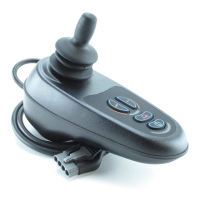VR2 CONTROL SYSTEM
SK77898/2
PG DRIVES TECHNOLOGY
110
2 Diagnostics
2.1 Introduction
The primary objective of this section is to assist service personnel in finding the likely
area of a detected fault within the whole wheelchair electrical system. It is important to
realize that even though the control system is signaling a fault, it may not be the
control system itself that is defective. This is because the control system is able to detect
problems in other electrical components (motors, batteries, solenoid brakes etc.) or,
more importantly, the wiring to them. When a control system has detected a fault a
system trip is indicated.
Using this guide, it is possible to define a trip as belonging to one of 10 types. Once
this type has been established, there are suggestions as to what the possible cause
may be.
The guide should only be used to decide the starting point of your own diagnosis, as
it is possible for the controller to indicate a fault in another component even though
the controller itself may be defective. Nevertheless, experience has shown that
connectors and wiring are the major cause of wheelchair electrical problems, so it is
necessary to examine these more vulnerable areas first.
Diagnostics should only be conducted by healthcare
professionals with in-depth knowledge of PGDT electronic
controllers. An incorrect or badly effected repair could result
in an unsafe set-up of a wheelchair. PGDT accept no liability
for losses of any kind arising from an incorrect or badly
effected repair.
2.2 Diagnostics Process
For efficient and effective diagnosis the following basic steps should be taken.
Establish the type of control system fitted to the wheelchair.
Confirm there is a trip, or has been an intermittent trip.
Establish the trip type.
Refer to the trip table.
Refer to the possible cause as indicated by the trip table, and carry out
recommended investigative and corrective action.

